
Adapted from Schvartzapel's recipe in Chambelland.
I've added candied strawberries, Valrhona caramel chocolate, and caramel chunks,
Image

Recently, I've focused on lievito madre feeding schedules, techniques for improving the microbial balance of LM, mixing procedures, timings of fermentation stages, and baking techniques.
There are literally hundreds of aspects to making panettone, and many of them are on the critical path for success. This is why it is so challenging, and also why it is so enjoyable and rewarding. Of course, eating the end product is very rewarding too.
- SueVT's Blog
- Log in or register to post comments
Well done, Sue.
How are you getting on with managing the acidity? Looks like you may have trapped an air pocket there while shaping. Have you been measuring the pH of the primo and secondo impasti?
I've tried the Shvartzapel recipe a few times now, I can't say I get on with it to be honest. Even from the beginning, mixing the first dough, Massari's is so much simpler to do and complete quickly by comparison. Although to be fair I must consider you have a much better mixer than the one I possess.
For Massari's, I combine the sugar and the water to a syrup, add butter and flour and mix until gluten develops, add the LM and finish the mix with the yolks. But Roy's first dough is much softer with more water and butter, which for me requires dividing up some of those ingredients into separate additions to mix effectively. Do you mix the ingredients as described in the book?
Michael
Yes, I have become much more methodical and precise about everything as I have gone along. I do measure pH at each stage, and results over the last few batches have been pretty consistent.
For the LM, I am maintaining between bakes by feeding 2x per day, a 40% refresh during the day, stored at room temp (mostly in the 75F range) as a formed ball with crosscut, in a small bowl, in a plastic box. Overnight, I feed a 30% refresh and then roll and coil, storing in water overnight.
I measure pH daily prior to refreshes.
Approaching baking, I do the night-time refresh at 40%, split off half and wrap for "next time", then store the other half of the working LM dry with crosscut in a box, waiting for the next morning's bake.
Bake day, I do a bagnetto (if I remember to do this), then give three 3.5-hour refreshes at 45% (this is Roy's mentioned percentage, so I follow it). These are stored at 27C to develop. The extra water and warmth does help to accelerate the LM. I check pH at the end of each refresh, as I know that it's important for the LM to "complete" the cycle prior to continuing. This last time, my three measurements were: 4.19, 4.15, and 4.09.
BTW I am on my second Hanna Bread pH meter, and I sometimes have to take a couple of measurements before trusting it.
Also, I am finding that the flour is critical and not all panettone flours are equal. I am using Petra and think it's great. I think Pasini is also v. good, but so far I can't get it.
1st Impasto: I combine water and sugar (in the spiral mixer). I whisk it a bit because the spiral will never get it there. Then flour until smooth dough, timing will depend on the mixer. Add LM till well developed gluten. Next, 1/3 yolks and all butter. Next, 1/3 yolks. Finally the last 1/3 yolks.
Overnight rise at 27-28C to triple. Here is where I am having what may be a problem. My pH at this point is Always low, and I believe it is supposed to be 5.3. This time it was 3.97. Last time it was 3.99. I do not understand what would cause it to be 5.3, this has never happened for me. However, I have been getting v. strong gluten development regardless as well as oven spring.
I did buy a titration kit but have not yet used it. If I do find pesky volatile acids, I need a new strategy to combat them. I have tried the flour-heavy feedings, bagnettos every day, plus a couple of other things I've been collecting in a document. I have not tried the one-time egg yolk treatment, which seems a bit dodgy to me.
2nd impasto: Starts with 1st dough + flour to desired (smooth) texture, looking for this new flour to develop before next step. (I am checking strength and windowpane periodically during the mix. Each step needs to be well incorporated before going to the next one). Next, the sugar, honey and 1/3 of yolks. Next, 1/3 of yolks and flavorings/extracts depending on the recipe. Next, the butter. Next, the salt. Next, the last 1/3 of the yolks. Next, the (cold) water, added Gradually. Finally, the add-ins, mixed only until well incorporated.
Preshape, wait 20, shape, pirlatura. I scale to 1050g in Novacart pans.
Rise 4 to 5 hours. I want to see a good rise but not over-risen. Glaze with Massari's recipe, then pearl sugar.
Bake at 170C for 55 minutes. I have started using my small combi oven with steam for the first 5 min, this worked better than my large oven.
Notes: This is not a wet dough, but it is a soft dough with a lot of elasticity. Handling characteristics have been good to excellent, this last one was excellent. The telling point seems to me to be the first step of the first impasto, getting that initial gluten development.
Thanks for the extra details.
I'm curious, how is it you can form a dough at 30% hydration? Your LM must be very broken down or do you mean 30% hydration not counting any extra water absorbed after a bagnetto? Do you have pictures of you LM at this maintenance stage? A healthy LM should be dough like, soft but not super degraded at all stages. I find it telling to measure the starting pH at the beginning of a refresh, this way I can gauge the TTA somewhat (acid load).
I was interested in the acidity aspect because with my experienced eyes I can see signs of elevated acidity in the crumb structure of your panettone. You're not alone though and most of my panettoni have suffered with this, although I've probably made a handful that were spot on at various points over the years. The end pH for the primo impasto should indeed be above pH5. This being another reason I find Shvartzapels recipe trying as the higher water content isn't going to help where over acidification is a problem.
It would be interesting to see what happens if you were to try Massari's (Dissapore) panettone formula as his is the true test of a proper LM with sufficient leavening power.
The relatively high pH for the primo impasto after rising is due to the sensitivity of F. sanfranciscensis to high sugar concentrations. This is described in Chambellands's book. The pH is important because it changes the quality of the gluten and with a high quantity of sugar and fats there is little room for error and this explains why some people report problems mixing the second dough, especially when incorporating fats.
Sorry, you are right, it is 40% for the overnight coiled water-stored LM, then 30% (after the bagnetto) to compensate for the water that creeps in from the bagnetto, for the daytime dry-stored ball of LM.
One of my sources does do a 30% coiled water-stored dough, and yes that is challenging. I have gotten it down to about 35% by working the dough for 6 minutes in the KA with aftermarket spiral hook, then rolling on my portable sheeter several times. That helps the dough to come together.
I need a strategy to adjust the acidity downward, as you pointed out. Any suggestions would be very welcome!
Thank you very much.
Hi Sue,
I would say the seeking of ever lower hydrations is perhaps a false economy. Firstly, because yeasts do not gain any metabolic or growth advantage at a stiff consistency. Secondly, problems may arise that result in poor activity and then too much stiffness which often leads to a panettone with poor flavour. Now I'm not saying this is the problem you might be experiencing, just that it is something to be aware of. One particular panettone I remember making, it leavened and baked up without issue, but the flavour and texture was all wrong, it tasted under fermented, as if the starch wasn't digested properly, it was coarse and dry and so very bland despite being loaded with fruit and flavourings.
Super stiff is fine, so long as it softens sufficiently after rising, but I can't imagine a LM at sub 40% hydration would be all that workable long term, unless one was using very weak flour.
What I have described above is one side of what can be a LM that is too strong, because the other side is a degraded primo impasto or sour tasting panettone. As it has been said somewhere before the LM can be too strong in two different ways.
Based on your pH readings your LM is indeed too strong. Do you have any pictures of the LM after rising and pictures of the primo impasto also after rising? Then I might be able to diagnose which side of too strong your LM might be on?
Michael
EDIT: Also, can you tell me the starting pH of the LM after mixing / before rising?
I'm not sure what advantage is gained by the lower hydration, but it doesn't seem like a stiff dough at any point except perhaps the first step of the 1st impasto, where you're mixing just flour and sugar water together. After that it is progressively more slack as other things are added. It's interesting that you mention flavor; Emma la Pergamina mentioned that her attempt at Roy's recipe seemed to lack flavor in her opinion, and she highlighted the different butter/water ratio as the cause also...
The crumb on Roy's panettone looks rather dry to me, at least compared to Giorilli etc.. sort of like the crumb of a popover or Yorkshire pudding. It looks like a rapidly-expanding butter/egg/milk dough, though panettone is quite different from that.
I am now using Petra 6384, which is a very strong flour and nice to use. Taste of finished product has been very good, and not sour.
Yes, my LM has varied, but has always been too acidic to produce the correct results with 1st impasto. I've been re-reading some of your posts, and have been feeding the LM very consistently since the last post. Each day, two 40% hydration feedings, 25C storage during the day, and placed on a cool porch for the overnight one. I'm giving a bagnetto every couple of days in the morning.
At the start of this period, pH was running in the 3.75 range after 12 to 16 hours of storage, and now it is running from 4.01 to 4.13. I have not tried the titration kit, but I think I should, to get the full picture. However the trend is in a positive direction. I haven't been measuring it after feeding but before rising, but I will start taking this measurement.
I'm hoping to get to a "correctly balanced" LM before attempting another bake, but not sure how I will identify that state!
Thank you very much,
Sue
Here are a couple of pictures showing dough etc